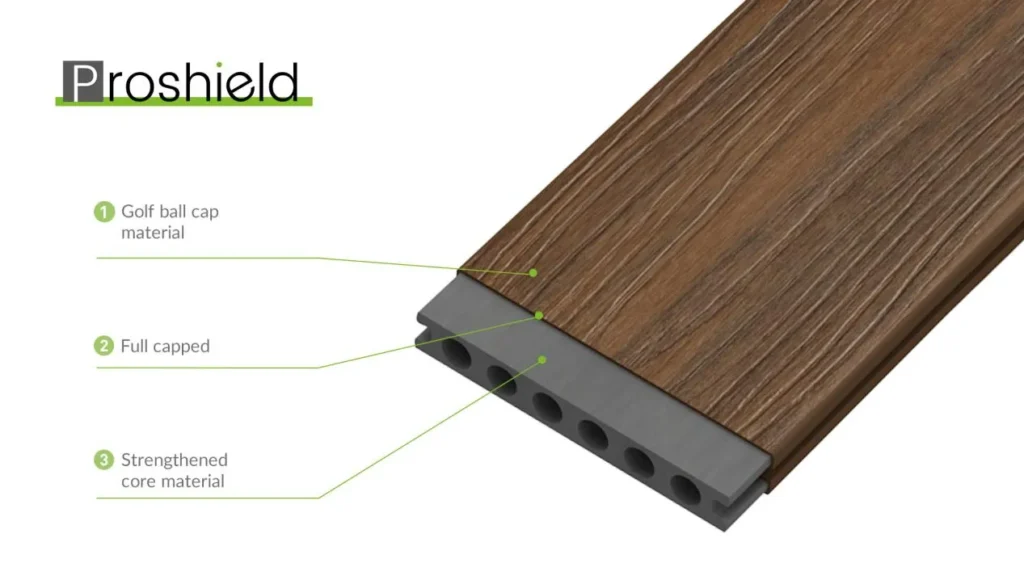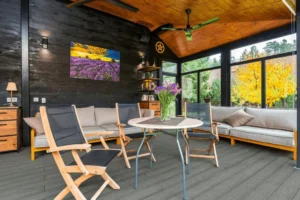Is Painting Your Composite Deck Worth It?

When it comes to maintaining the aesthetic appeal of your outdoor space, your deck plays a crucial role. A well-maintained deck enhances the beauty of your home and provides a functional area for relaxation and entertainment. However, if you have a composite deck, you might find yourself asking, “Can I paint or stain this deck to refresh its look?” The answer is not straightforward—it depends on the type of composite decking you have. This article will guide you through understanding your decking material, evaluating your options, and outlining the steps involved in painting uncapped composite decking, along with considerations for long-term maintenance.
Understanding Composite Decking Types
Before diving into painting or staining, it’s essential to understand the type of composite decking you have. Composite decking has evolved over the years, and not all types are suitable for painting.
– Modern Composite Decking:
Modern composite decking often features a polymer cap, which serves as a protective layer over the composite core. This capping provides excellent resistance to moisture, UV rays, and general wear and tear, ensuring the decking remains in good condition with minimal maintenance. However, this protective layer also makes modern composite boards unsuitable for painting or staining. Attempting to paint polymer-capped boards can damage the protective surface, cause peeling, and void the manufacturer’s warranty.
– Older Composite Decking:
Older composite decking, on the other hand, is typically uncapped, meaning it lacks the protective polymer layer found in modern boards. These uncapped boards are more receptive to paint and stain, making them a viable option if you’re looking to refresh the appearance of your deck. However, it’s crucial to confirm that your decking is uncapped before proceeding with any painting or staining projects.
Pre-Painting Considerations
Before you start painting composite deck, there are several important factors to consider to ensure the success of your project and avoid potential pitfalls.
– Manufacturer Guidelines:
The first step in any deck painting project should be to consult the manufacturer’s guidelines for your specific decking material. Different manufacturers have varying recommendations regarding painting or staining, and failing to follow these guidelines could result in voiding the warranty on your decking. Some manufacturers may explicitly advise against painting or sealing their products due to the potential for damage or increased maintenance requirements.
– Deck Inspection:
Once you’ve reviewed the manufacturer’s recommendations, it’s time to inspect your deck to assess its condition and determine its suitability for painting. Look for signs of damage such as swelling, cracking, or splitting, as these issues need to be addressed before any painting or staining can occur. Additionally, closely examine the ends of the boards or any exposed cuts to verify whether your decking is capped or uncapped. Only proceed with painting if your deck is uncapped and in good structural condition.
Step-by-Step Guide to Painting Uncapped Composite Decking
If you’ve determined that your uncapped composite decking is suitable for painting, you can follow these steps to achieve a fresh, new look for your outdoor space.
1. Cleaning the Deck:
The first step in preparing your deck for painting is a thorough cleaning. Start by removing all furniture, decor, and any loose debris from the surface. Pay special attention to cleaning between the deck boards and along the edges where leaves and other debris may have accumulated. Use a crevice cleaning tool to remove any trapped material.
Next, consult the cleaning guidelines provided by your decking manufacturer. Use the recommended deck cleaner and a suitable brush to scrub the surface thoroughly. Ensure you remove all traces of dirt, mold, and mildew, as any remaining contaminants can prevent the paint from adhering properly. Once the cleaning process is complete, rinse the deck with clean water and allow it to dry completely before moving on to the next step. If you don’t know how to clean a composite deck properly, check this article: Tips for WPC Decking Care and Cleaning.
2. Sanding the Deck (Optional):
After cleaning, consider sanding the deck to create a rougher surface that will help the paint adhere better. Use 240-grit sandpaper and a power sander or sand the boards manually. Be mindful that sanding can alter the texture and finish of the decking, particularly if it has any grain or slip-resistant coatings. Weigh the benefits of improved paint adhesion against the potential for damaging the deck’s original surface before deciding to sand.
Once sanding is complete, remove any remaining dust and debris using a broom, leaf blower, or cloth. This ensures a clean, smooth surface for priming and painting.
3. Applying Primer:
While not always necessary, applying a primer can help create a smoother foundation for your paint and improve the overall finish. Choose a primer that is compatible with your decking material, and follow the manufacturer’s recommendations for application.
Begin by using a brush to apply primer to the gaps and crevices in the deck surface. Then, use a roller or brush to apply a full coat of primer across the entire deck. Make sure to apply the primer evenly to avoid streaks or missed spots. Allow the primer to dry completely according to the manufacturer’s instructions before proceeding to paint.
4. Painting the Deck:
With the primer dry, you’re ready to apply the paint. Choose an exterior-rated paint that is designed for use on composite materials. Using a telescoping roller, apply an even coat of paint to the deck surface. For intricate details and edges, use a hand brush to ensure full coverage.
Depending on the paint and the desired finish, you may need to apply a second coat. Allow each coat to dry thoroughly before applying the next. Once the final coat is dry, your deck will have a fresh, updated appearance.
5. Sealing the Painted Deck (Optional):
To enhance the durability of your newly painted deck, consider applying a sealer. This step is optional but can significantly extend the life of the paint and reduce the frequency of maintenance. Apply the sealer using a roller, just as you did with the primer and paint, and allow it to dry completely before using the deck.
Long-Term Maintenance and Considerations
While painting can refresh the look of your uncapped composite deck, it’s important to understand that this process will increase the maintenance requirements. The paint may degrade, chip, or peel over time, especially in areas exposed to high foot traffic or harsh weather conditions. You should be prepared to repaint your deck every few years to maintain its appearance.
For those seeking a low-maintenance solution, upgrading to modern capped composite decking might be a better long-term investment. Capped boards offer superior protection against fading, staining, and UV damage, eliminating the need for painting while providing a durable, attractive surface. Oakio’s Proshield capped composite deck is a good choice for its golf ball material cap and strengthened core material.

Conclusion
Deciding whether to paint your composite deck requires careful consideration of the type of decking you have and the potential impact on maintenance and longevity. By following the steps outlined above, you can successfully paint uncapped composite decking, achieving a refreshed look for your outdoor space. However, be mindful of the increased maintenance that comes with a painted deck and consider alternative solutions that may better suit your needs.
Trending Reading
What Are the Differences Between the WPC Board and PVC Board?
[2024 Update] How Long Does WPC Decking Last?











